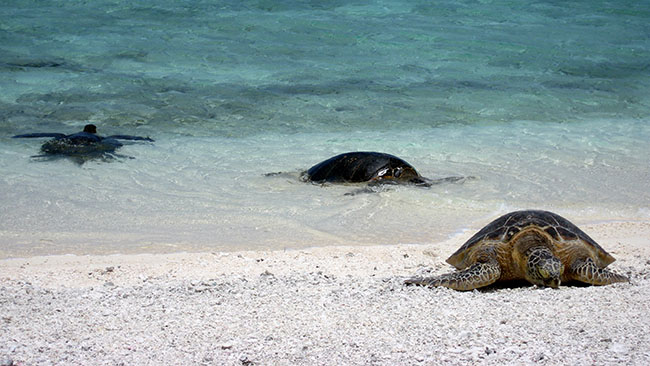The sun sets over an endless sea, flashing a mysterious green, while a purple squall stomps on the horizon. I stand in the middle of a sandy island the size of a graveyard, and just as flat. This is exactly what I want after the last ten months—time alone on a deserted island in the middle of the Pacific Ocean. It’s what I hope will right my world that’s canted 27 degrees to the left, one degree for each year of marriage. Is what I hope will rid me of the ghost of a perfect husband, a perfect marriage, a perfect life.
Almost the entirety of the Green sea turtle population comes to this one islet to nest, relying on their chunky flippers to swim hundreds of miles to find a spot to lay their eggs. It took me three days on a scientific research ship to arrive at French Frigate Shoals, 500 miles northwest of Honolulu. “But, Mom, why do you have to go so far away?” Sarah had asked.
How do you explain to your daughter that sometimes distance is what the heart needs? That comfort comes from other than family?
I turned to my first love. Before Dan. I’d always wanted to study turtles. But expectations. Marriage. Responsibilities. Sarah.
After sunset, the skies are dark near the equator, and I slip a pair of night-vision goggles over my head, pulling the strap tight so they won’t slide down my nose—like a pug dog, Dan said in the before days. I turn clockwise—to right the listing my life has taken since Dan’s heart attack—and thumb a button on a counter in my hand every time a turtle, glowing in the green light of my goggles, emerges from the sea, as they do at night to lay their eggs. The sand is course, made of coral, but I cannot feel the way it bites into the souls of my feet, my skin having gone numb over the months. The storm continues to dance, a curtain in the wind, warm raindrops tapping my skin and growing more insistent. Another turn adds three more clicks to the counter. Last year, a hurricane blew through here, sinking the coral rubble islet, freaking out scientists worried that climate change may eliminate a species that’s been around since the time of dinosaurs.
I turn and click and turn and click and turn and click. Wind whips the rain around me, water dripping from my hair and trailing down my back. It takes 60 seconds to turn and scan the entire islet. At this rate, I’ll corkscrew myself into the ground so deep, I’ll come out the other side of the world, another ocean, somewhere off the coastline of Namibia. Would that be far enough away to shed the grief heavy about my eyes? The ocean’s currents pushed most of the rubble back into its previous shape, rising a few feet above the ocean’s surface, just in time for this year’s nesting season. Does a heart rebound to its original shape after loss?
Turtles of all sizes are coming ashore now. Something slaps my ankle. I slip off the goggles and see a turtle, its teardrop-shaped shell with its characteristic geometric scutes some four-feet in diameter. She’s flinging sand with her back flippers. I squat and reach for the reptile’s glistening carapace, iridescent in the rain. She has to be pushing a hundred. My hand hovers, but I cannot interfere with a millions-year-old ritual, and I pull my hand back. The turtle gives up on her first pit, moves a few feet away and starts another. Abandons it. After digging five pits, relying on some inner voice, she pauses over one. Now, I count the soft ping-pong-ball-sized blobs that she excretes—87. Her flippers go to work again, covering her precious cargo in a mound. Then, she turns for the sea, her home, and starts her hundreds-mile journey back to her life along the coastlines of the Hawaiian Islands.
Minutes pass. The rain fades, the squall passes, replaced by pin-pricked skies displaying millions of stars, a wash of the Milky Way, so bright this far from civilization. I go back to turning and clicking, turning and clicking, turning and clicking. Thirty minutes before sunrise, I take another look at the mound a few feet away, the stirrings of life underground.
I haven’t thought of Dan for six hours. It’s a start.
This work was previously published in the Hawai`i Pacific Review
Kim Steutermann Rogers lives with her husband and 16-year-old dog Lulu in Hawaii. Her essay, “Following the Albatross Home” was recognized as notable in Best American Travel Writing. Her science journalism has published in National Geographic, Audubon, and Smithsonian; and her prose in Fractured Lit, The Citron Review, Milk Candy Review, Gone Lawn, Bending Genres, CHEAP POP, Hippocampus, and elsewhere. Find her on social media @kimsrogers.

